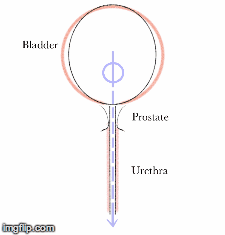For many men, as we get older the prostate gland becomes larger. The reasons for this are not completely understood, but it is certainly a condition that can run in families. There are no effective lifestyle changes that can alter growth of the prostate gland.
What are the consequences of BPE?
Depending on how the prostate grows, there may no symptoms or problems at all with an enlarged prostate. In such cases, no treatment is required. BPE is not a risk factor for prostate cancer.
However, sometimes prostate growth will impair urine flow from the bladder. This happens, because the first part of the urethra as it leaves the bladder goes through the middle of the prostate gland. So an enlarged prostate can squeeze on the outflow tract of urine from the bladder.
To a point, the bladder will adapt to this by becoming more muscular and generating more pressure to expel urine. However, these bladder changes will often make the bladder more irritable, and as a result you often have bothersome symptoms of overactive bladder.
You may notice some or all of these:
- Poor flow
- Going frequently during the day
- Getting up many times at night (nocturia)
- Having to rush to the toilet with very little warning (urgency)
- Not being able to reach the toilet in time (urge incontinence)
- Feeling of incomplete emptying
- Having to strain to start the flow of urine
Left untreated, further complications sometimes occur:
- Complete inability to pass urine (urinary retention)
- Haematuria (blood in the urine)
- Urinary tract infections
- Bladder stones
- Kidney failure
What further tests may be required?
- Urine tests
To look for infection or microscopic bleeding.
- Blood tests
To assess kidney function and PSA.
- Urinary tract ultrasound
As for pregnant women, ultrasound imaging can give us information about internal organs without any radiation. The urinary tract ultrasound will assess the kidneys, bladder and prostate. The scan is done in two parts. For the first part, you should try to have a full bladder. Then after going to the toilet, a further scan will be done to assess how well the bladder has emptied.
- Voiding flow rate
- Urodynamics
What are the treatment options?
- Alternative therapies
Various supplements of herbal remedies, such as Saw Palmetto, Pygeum and Stinging Nettle, are marketed to use for prostate enlargement. Unfortunately, studies into these agents have in general shown no or little symptom benefit. While unlikely to be harmful, these supplements are expensive, and I do not recommend their use.
- Daily tablets
Two classes of medication can be useful when taken regularly.
Alpha-blockers (Tamsulosin, Prazosin) work to relax the muscular component of the prostatic stroma, and therefore allow better flow through the gland. Side-effects can include dizziness when standing up, loss of ejaculation and nasal stuffiness. These medications improve the symptoms of prostate enlargement. However, they don’t affect the underlying prostate enlargement, and don’t reduce your risk of complications or needing surgery down the track.
5-alpha reductase inhibitors (Duasteride, Finasteride) reduce the amount of active testosterone in the prostate, leading to a 30% reduction in gland size over 12 months. Side-effects can include hair regrowth in balding men, nipple tenderness and swelling, reduced ejaculate volume and erectile dysfunction. Both classes of medication can be given in a single combination tablet (Dutasteride/Tamsulosin).
- Definitive endoscopic surgery
When tablets are not wanted or not working out, surgery offers a definitive alternative to remedy the urinary flow obstruction caused by an enlarged prostate.
There are many different techniques, but all aim to create a better channel through the prostate. Transurethral Resection of the Prostate (TURP) has been the gold standard operation, and remains a reliable option for many patients. Newer techniques seek to emulate the results of TURP, while minimising the side-effects such as blood loss and recovery time.
My preferred technique for most of my patients is greenlight laser prostate vaporisation.
A further option now available for some men is the Urolift procedure.
